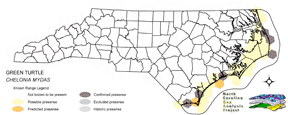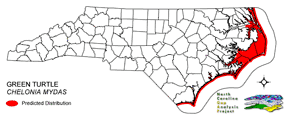
| Taxa: |
| Order: |
| Family: |
| Reptilia |
| Testudines |
| Cheloniidae |
| NatureServe Global Rank: |
| NatureServe State (NC) Rank: |
| G3 |
| S1B,SZN |
| Federal Status: |
| NC State Status: |
| LT |
| T |


| Land Unit |
| US Fish & Wildlife Service |
| US Forest Service |
| US National Park Service |
| US Department of Defense |
| NC State Parks |
| NC University System |
| NC Wildlife Res. Com. |
| NC Forest Service |
| NC Div. of Coastal Mgmt. |
| Local Governments |
| Non-Governmental Org. |
| Other Public Lands |
| Private Lands |
| GAP Status 1-2 |
| All Protected Lands |
| Statewide |
| Hectares |
| 341.46 |
| 4.59 |
| 253.89 |
| 1,024.56 |
| 112.14 |
| 0.00 |
| 29.34 |
| 0.00 |
| 206.91 |
| 0.00 |
| 39.69 |
| 0.36 |
| 3,299.94 |
| 1,304.73 |
| 2,010.51 |
| 5,312.88 |
| Acres |
| 843.77 |
| 11.34 |
| 627.38 |
| 2,531.74 |
| 277.10 |
| 0.00 |
| 72.50 |
| 0.00 |
| 511.29 |
| 0.00 |
| 98.08 |
| 0.89 |
| 8,154.33 |
| 3,224.06 |
| 4,968.08 |
| 13,128.41 |
| % of Dist. on |
| Prot. Lands |
| 17.0 % |
| 0.2 % |
| 12.5 % |
| 51.0 % |
| 5.6 % |
| 0.0 % |
| 1.5 % |
| 0.0 % |
| 10.3 % |
| 2.0 % |
| 2.0 % |
| < 0.1 % |
| 0.0 % |
| 64.9 % |
| ----- |
| ----- |
| % of Dist. on |
| All Lands |
| 6.4 % |
| < 0.1 % |
| 4.8 % |
| 19.3 % |
| 2.1 % |
| 0.0 % |
| 0.6 % |
| 0.0 % |
| 3.9 % |
| 0.0 % |
| 0.7 % |
| < 0.1 % |
| 62.1 % |
| 24.6 % |
| ----- |
| ----- |
|
Ranges south from the coast of New England. Although nesting has been documented in the past at Camp Lejeune in Onslow County (Ernst et al. 1994) the species is seen only occasionally in North Carolina (Martof et al. 1980). Migrates in the open ocean, often near the shore in water less than 50 m deep. Forages on submerged vegetation in quiet, shallow water, usually in well-lighted areas that favor the growth of algae and other aquatic plant and animal life. Juveniles also frequent these areas during their development. Beaches chosen for nesting are generally flat (rising 2-3m above the water) with low wave energy. On islands, nests may be placed more frequently on the sound side (Ernst et al. 1994). Mating occurs in shallow water near the nesting beach. The nest is dug on the open beach or in the vegetation behind the dunes. The turtles rest in deep water when not feeding; at night they sleep on the bottom or on a ledge above the water level. Hatchlings often spend the first year or so of their lives floating with mats of sargassum (Ernst et al. 1994). NATURE SERVE GLOBAL HABITAT COMMENTS: Most commonly feeds in shallow, low-energy waters with abundant submerged vegetation. Migrates across open seas. Adults are tropical in distribution, whereas juveniles range into temperate waters. Hatchlings often float in masses of sea plants (e.g., Sargassum) in convergence zones. Coral reefs and rocky outcrops near feeding pastures often are used as resting areas. Inactive on the bottom in winter in the northern Gulf of California. Basks on beaches in some areas (e.g., Hawaii). Nests on beaches, usually on islands but also on mainland. Sand may be coarse to fine, has little organic content; physical characteristics vary greatly in different regions. Prefers high energy beaches with deep sand. At least in some regions, generally nests at same beach (apparently the natal beach, Meylan et al. 1990, Allard et al. 1994) in successive nestings, though individuals sometimes change to different nesting beach within a single nesting season; has switched to beach up to several hundred kilometers away (see Eckert et al. 1989). Beach development and illumination often makes beaches unsuitable for successful nesting. NATURE SERVE STATE HABITAT COMMENTS: Pelagic except for nesting. Nests on ocean-facing sandy beaches. Juveniles are found in small numbers throughout coastal waters. |
| Code | Name | Description | NC Natural Heritage Program Equivalent |
| 378 | Ocean Beaches | Open beach sand. | Upper Beach |
| 375 | Hypersaline coastal salt flats | Tidal flats within salt marshes, including saltmeadow cordgrass or sea-purslane dominated alliances. | Salt Marsh |
| 371 | Maritime Grasslands | Dune grass community consisting of sea oats and beach grasses. | Dune grass, Maritime dry grassland |
| 8 | Open water | Open water without aquatic vegetation. | No equivalent |
|
U.S. Fish & Wildlife Service. 1980. Selected vertebrate endangered species of the seacoast of the United States - green sea turtle. FWS/OBS-80/01.13.
Hirth, H. F. 1980. Chelonia mydas. Cat. Am. Amph. Rep. 249.1-249.4. Dodd, C. K., Jr. 1981. Nesting of the green turtle, Chelonia mydas (L.), in Florida:historic review and present trends. Brimleyana 7:39-54. Balazs, G. H. 1982*. Status of sea turtles in the Central Pacific Ocean. Pages 243-252 in Bjorndahl, K. A., editor. Biology and conservation of sea turtles. Smithsonian Institution Press, Washington, D.C. *Copyright date; 1981 on title page. Mack, D., N. Duplaix, and S. Wells. 1982*. Sea turtles, animals of divisible parts:international trade in sea turtle products. Pages 545-563 in Bjorndahl, K. A., editor.Biology and conservation of sea turtles. Smithsonian Institution. Whittow, G. C., and G. H. Balazs. 1982. Basking behavior of the Hawaiian green turtle (CHELONIA MYDAS). Pacific Sci.36:129- . Limpus, C. J., E. Gyuris, and J. D. Miller. 1988. Reassessment of the taxonomic status of the sea turtle genus NATATOR (McCulloch 1908 with a redescription of the genus and species. Trans. Royal Society S. Australia 112(1/2):1-10. Ehrhart, L. M., and B. E. Witherington. 1992. Green turtle CHELONIA MYDAS (Linnaeus). Pages 90-94 in P. E. Moler, editor. Rare and endangered biota of Florida. Vol. III. Amphibians and reptiles. Univ. Press of Florida. Frazer, N. B. 1992. Sea turtle conservation and halfway technology. Conservation Biology 6:179-184. Green, D. 1993. Growth rates of wild immature green turtles in the Galapagos Islands, Ecuador. J. Herpetology 27:338-341. Tuato`o-Bartley, N., T. E. Morrell, and P. Craig. 1993. Status of sea turtles in American Samoa in 1991. Pacific Science 47(3):215-221. Allard, M. W., et al. 1994. Support for natal homing in green turtles from mitochondrial DNA sequences. Copeia 1994:34-41. Conant, R. and J. T. Collins. 1991. A field guide to reptiles and amphibians:eastern and central North America. Third edition. Houghton Mifflin Co., Boston, Massachusetts. 450 pp. Losey, G. S., G. H. Balazs, and L. A. Privitera. 1994. Cleaning symbiosis between the wrasse, THALASSOMA DUPERRY, and the green turtle, CHELONIA MYDAS. Copeia 1994:684-690. Witherington, B. E. 1992. Behavioral responses of nesting sea turtles to artificial lighting. Herpetologica 48:31-39. Ernst, C. H., R. W. Barbour, and J. E. Lovich. 1994. Turtles of the United States and Canada. Smithsonian Institution Press, Washington, D.C. xxxviii + 578 pp. Eckert, K. L., et al. 1989. Inter-nesting migrations by leatherback sea turtles (DERMOCHELYS CORIACEA) in the West Indies. Herpetologica 45:190-194. Mortimer, J. A., and K. M. Porter. 1989. Reproductive homing and internesting behavior of the green turtle (CHELONIA MYDAS) at Ascension Island, South Atlantic Ocean. Copeia 1989:962-977. Witherington, B. E., and L. M. Ehrhart. 1989. Hypothermic stunning and mortality of marine turtles in the Indian River Lagoon System, Florida. Copeia 1989:696-703. Fritts, T. H., W. Hoffman, and M. A. McGehee. 1983. The distribution and abundance of marine turtles in the Gulf of Mexico and nearby Atlantic waters. J. Herpetology 17:327-344. Meylan, A. B., B. W. Bowden, and J. C. Avise. 1990. A genetic test of the natal homing versus social facilitation models for green turtle migration. Science 248:724-727. Ernst, C. H., and R. W. Barbour. 1972. Turtles of the United States. Univ. Press of Kentucky, Lexington. x + 347 pp. McKeown, S. 1978. Hawaiian reptiles and amphibians. Oriental Pub. Co., Honolulu. 80 pp. Balazs, G. H. 1980. Synopsis of biological data on the green turtle in the Hawaiian Islands. NOAA Tech. Memo. NMFS. NOAA-TM-NMFS-SWFC-7. Martof, B. S., W. M. Palmer, J. R. Bailey, and J. R. Harrison, III. 1980. Amphibians and reptiles of the Carolinas and Virginia. University of North Carolina Press, Chapel Hill, North Carolina. 264 pp. Frazer, N. B., and L. M. Ehrhart. 1985. Preliminary growthmodels for green, CHELONIA MYDAS, and loggerhead, CARETTA CARETTA, turtles in the wild. Copeia 1985:73-79. Luxmoore, R., and J. Canin. 1985. International trade in raw sea turtle shell. IUCN Wildlife Trade Monitoring Unit, Traffic Bulletin 7(2):30-39. Bjorndal, K. A., editor. 1982*. Biology and conservation of sea turtles. Smithsonian Institution Press, Washington, D.C. 583 pp. *Copyright date; date on title page is "1981.". Mrosovsky, N. 1983. Conserving sea turtles. British Herpetological Society. 176 pp. Van Meter, V. B. 1983. Florida's sea turtles. Florida Power & Light Company, Miami. 46 pp. Marine Turtle Recovery Team. 1984. Recovery plan for marine turtles (loggerhead turtle, green turtle, leatherbackturtle, hawksbill turtle, and Kemp's ridley turtle). Natl. Mar. Fish. Serv. and U.S. Fish and Wildife Service 363 pp. Zangerl, R., L. P. Hendrickson, and J. R. Hendrickson. 1988. A redescription of the Australian flatback sea turtle, NATATOR DEPRESSUS. Bishop Museum Bull. Zoology 1:1-69. Ernst, C. H., and R. W. Barbour. 1989. Turtles of the world. Smithsonian Institution Press, Washington, D.C. xii + 313 pp. National Marine Fisheries Service and U.S. Fish and Wildlife Service. 1995. Status reviews for sea turtles listed under the Endangered Species Act of 1973. National Marine Fisheries Service, Silver spring, Maryland. vi + 139 pp. Groombridge, B., and R. Luxmoore. 1989. The green turtle and hawksbill (Reptilia:Cheloniidae):world status, exploitation and trade. Secretariat of the Convention on International Trade in Endangered Species of Wild Fauna and Flora, Lausanne, Switzerland. King, F. W., and R. L. Burke, editors. 1989. Crocodilian, tuatara, and turtle species of the world:a taxonomic and geographic reference. Association of Systematics Collections, Washington, D.C. 216 pp. Committee on Sea Turtle Conservation (CSTC), National Research Council (U.S.). 1990. Decline of the Sea Turtles:Causes and Prevention. National Academy Press, Washington, D.C. xv + 259 pp. U.S. Fish and Wildlife Service (USFWS). 1990. Endangered and threatened species recovery program:report to Congress. 406 pp. Matthews, J. R., and C. J. Moseley (editors). 1990. The Official World Wildlife Fund Guide to Endangered Species of North America. Volume 1. Plants, Mammals. xxiii + pp 1-560 + 33 pp. appendix + 6 pp. glossary + 16 pp. index. Volume 2. Birds, Reptiles, Amphibians. Iverson, J. B. 1991. Patterns of survivorship in turtles (order Testudines). Canadian J. Zoology 69:385-391. Mitchell, J. C. 1991. Amphibians and reptiles. Pages 411-76 in K. Terwilliger (coordinator). Virginia's Endangered Species:Proceedings of a Symposium. McDonald and Woodward Publishing Company, Blacksburg, Virginia. Collazo, J. A., R. Boulon, Jr., and T. L. Tallevast. 1992. Abundance and growth patterns of CHELONIA MYDAS in Culebra, Puerto Rico. J. Herpetology 26:293-300. |
For more information please contact them at:
NC-GAP Analysis Project
Dept. of Zoology, NCSU
Campus Box 7617
Raleigh, NC 27695-7617
(919) 513-2853
www.basic.ncsu.edu/ncgap